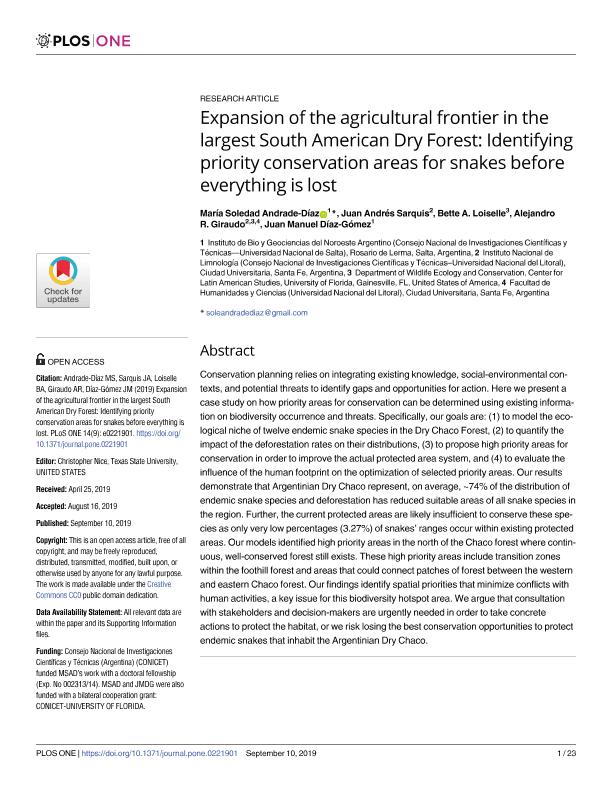Mostrar el registro sencillo del ítem
dc.contributor.author
Andrade Díaz, Soledad María

dc.contributor.author
Sarquis, Juan Andrés

dc.contributor.author
Loiselle, Bette A.
dc.contributor.author
Giraudo, Alejandro Raul

dc.contributor.author
Diaz Gomez, Juan Manuel

dc.date.available
2020-12-11T17:37:00Z
dc.date.issued
2019-09-10
dc.identifier.citation
Andrade Díaz, Soledad María; Sarquis, Juan Andrés; Loiselle, Bette A.; Giraudo, Alejandro Raul; Diaz Gomez, Juan Manuel; Expansion of the agricultural frontier in the largest South American Dry Forest: Identifying priority conservation areas for snakes before everything is lost; Public Library of Science; Plos One; 14; 9; 10-9-2019; 1-23
dc.identifier.issn
1932-6203
dc.identifier.uri
http://hdl.handle.net/11336/120252
dc.description.abstract
Conservation planning relies on integrating existing knowledge, social-environmental contexts, and potential threats to identify gaps and opportunities for action. Here we present a case study on how priority areas for conservation can be determined using existing information on biodiversity occurrence and threats. Specifically, our goals are: (1) to model the ecological niche of twelve endemic snake species in the Dry Chaco Forest, (2) to quantify the impact of the deforestation rates on their distributions, (3) to propose high priority areas for conservation in order to improve the actual protected area system, and (4) to evaluate the influence of the human footprint on the optimization of selected priority areas. Our results demonstrate that Argentinian Dry Chaco represent, on average, ~74% of the distribution of endemic snake species and deforestation has reduced suitable areas of all snake species in the region. Further, the current protected areas are likely insufficient to conserve these species as only very low percentages (3.27%) of snakes’ ranges occur within existing protected areas. Our models identified high priority areas in the north of the Chaco forest where continuous, well-conserved forest still exists. These high priority areas include transition zones within the foothill forest and areas that could connect patches of forest between the western and eastern Chaco forest. Our findings identify spatial priorities that minimize conflicts with human activities, a key issue for this biodiversity hotspot area. We argue that consultation with stakeholders and decision-makers are urgently needed in order to take concrete actions to protect the habitat, or we risk losing the best conservation opportunities to protect endemic snakes that inhabit the Argentinian Dry Chaco.
dc.format
application/pdf
dc.language.iso
eng
dc.publisher
Public Library of Science

dc.rights
info:eu-repo/semantics/openAccess
dc.rights.uri
https://creativecommons.org/licenses/by-nc-sa/2.5/ar/
dc.subject
Expansion of the agricultural frontier
dc.subject
South American Dry Forest
dc.subject
Priority conservation areas
dc.subject
Snakes
dc.subject.classification
Conservación de la Biodiversidad

dc.subject.classification
Ciencias Biológicas

dc.subject.classification
CIENCIAS NATURALES Y EXACTAS

dc.title
Expansion of the agricultural frontier in the largest South American Dry Forest: Identifying priority conservation areas for snakes before everything is lost
dc.type
info:eu-repo/semantics/article
dc.type
info:ar-repo/semantics/artículo
dc.type
info:eu-repo/semantics/publishedVersion
dc.date.updated
2020-11-20T17:39:30Z
dc.journal.volume
14
dc.journal.number
9
dc.journal.pagination
1-23
dc.journal.pais
Estados Unidos

dc.journal.ciudad
San Francisco
dc.description.fil
Fil: Andrade Díaz, Soledad María. Consejo Nacional de Investigaciones Científicas y Técnicas. Centro Científico Tecnológico Conicet - Salta. Instituto de Bio y Geociencias del Noroeste Argentino. Universidad Nacional de Salta. Facultad de Ciencias Naturales. Instituto de Bio y Geociencias del Noroeste Argentino; Argentina
dc.description.fil
Fil: Sarquis, Juan Andrés. Consejo Nacional de Investigaciones Científicas y Técnicas. Centro Científico Tecnológico Conicet - Santa Fe. Instituto Nacional de Limnología. Universidad Nacional del Litoral. Instituto Nacional de Limnología; Argentina
dc.description.fil
Fil: Loiselle, Bette A.. University of Florida; Estados Unidos
dc.description.fil
Fil: Giraudo, Alejandro Raul. Consejo Nacional de Investigaciones Científicas y Técnicas. Centro Científico Tecnológico Conicet - Santa Fe. Instituto Nacional de Limnología. Universidad Nacional del Litoral. Instituto Nacional de Limnología; Argentina. University of Florida; Estados Unidos. Universidad Nacional del Litoral. Facultad de Humanidades y Ciencias; Argentina
dc.description.fil
Fil: Diaz Gomez, Juan Manuel. Consejo Nacional de Investigaciones Científicas y Técnicas. Centro Científico Tecnológico Conicet - Salta. Instituto de Bio y Geociencias del Noroeste Argentino. Universidad Nacional de Salta. Facultad de Ciencias Naturales. Instituto de Bio y Geociencias del Noroeste Argentino; Argentina
dc.journal.title
Plos One

dc.relation.alternativeid
info:eu-repo/semantics/altIdentifier/doi/http://dx.doi.org/10.1371/journal.pone.0221901
dc.relation.alternativeid
info:eu-repo/semantics/altIdentifier/url/https://journals.plos.org/plosone/article?id=10.1371/journal.pone.0221901
Archivos asociados
